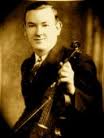Annotation:Paddy Killoran's (1): Difference between revisions
No edit summary |
No edit summary |
||
| (2 intermediate revisions by 2 users not shown) | |||
| Line 1: | Line 1: | ||
---------- | |||
---- | {{TuneAnnotation | ||
|f_tune_annotation_title= https://tunearch.org/wiki/Annotation:Paddy_Killoran's_(1) > | |||
'''PADDY KILLORAN'S [1].''' AKA and see "[[Sweeney's Dream]]," "[[Girl with the Laughing Eyes (The)]]." Irish, Reel. D Major. Standard tuning (fiddle). AAB. The title refers to the great south County Sligo fiddle player Paddy Killoran (1903-1965), while the alternate title "Sweeney's Dream" honors his contemporary and recording partner Paddy Sweeney (1894-1974), also from south Sligo. Killoran and Sweeney recorded the tune as a duet in the 1930's (as "[[Sweeney's Dream]]"). Killoran was born in the townland of Emlaghgissan, near Ballymote, and came from a musical family (his father played the flute, and mother the concertina), where he learned his first music. Other important influences were John Joe Gardiner, Philip O’Beirne and James Morrison. He emigrated to the United States in 1925 and formed a band called the Pride of Erin Orchestra, who broadcast weekly on the radio from Brooklyn, and who were in great demand at greater New York Irish dance halls. | |f_annotation='''PADDY KILLORAN'S [1].''' AKA and see "[[Sweeney's Dream]]," "[[Girl with the Laughing Eyes (The)]]." Irish, Reel. D Major. Standard tuning (fiddle). AAB. The title refers to the great south County Sligo fiddle player Paddy Killoran (1903-1965), while the alternate title "Sweeney's Dream" honors his contemporary and recording partner Paddy Sweeney (1894-1974), also from south Sligo. Killoran and Sweeney recorded the tune as a duet in the 1930's (as "[[Sweeney's Dream]]"). Killoran was born in the townland of Emlaghgissan, near Ballymote, and came from a musical family (his father played the flute, and mother the concertina), where he learned his first music. Other important influences were John Joe Gardiner, Philip O’Beirne and James Morrison. He emigrated to the United States in 1925 and formed a band called the Pride of Erin Orchestra, who broadcast weekly on the radio from Brooklyn, and who were in great demand at greater New York Irish dance halls. | ||
[[File:Killoran.jpg|200px|thumb|left|Paddy Killoran]] | [[File:Killoran.jpg|200px|thumb|left|Paddy Killoran]] | ||
David Taylor (1992) identifies a tune in Breandan Breathnach's '''Ceol Rince na hÉireann, vol. 1''', No. 126, as being similar, though perhaps not a variant. | David Taylor (1992) identifies a tune in Breandan Breathnach's '''Ceol Rince na hÉireann, vol. 1''', No. 126, as being similar, though perhaps not a variant. | ||
|f_source_for_notated_version= | |||
|f_printed_sources=Taylor ('''The Crossroads Dance'''), 1992; No. 3, p. 5. | |||
|f_recorded_sources=Shaskeen - "Mouse Behind the Dresser." | |||
|f_see_also_listing=Alan Ng's Irishtune.info [https://www.irishtune.info/tune/1858/]<br> | |||
}} | |||
<br> | |||
Latest revision as of 14:48, 3 July 2023
X:1 T:Paddy Killoran's [1] M:C| L:1/8 K:D d~F3 ABdf|gfeg fdBc|d~F3 ABdB|AFDF EF D2:|...
PADDY KILLORAN'S [1]. AKA and see "Sweeney's Dream," "Girl with the Laughing Eyes (The)." Irish, Reel. D Major. Standard tuning (fiddle). AAB. The title refers to the great south County Sligo fiddle player Paddy Killoran (1903-1965), while the alternate title "Sweeney's Dream" honors his contemporary and recording partner Paddy Sweeney (1894-1974), also from south Sligo. Killoran and Sweeney recorded the tune as a duet in the 1930's (as "Sweeney's Dream"). Killoran was born in the townland of Emlaghgissan, near Ballymote, and came from a musical family (his father played the flute, and mother the concertina), where he learned his first music. Other important influences were John Joe Gardiner, Philip O’Beirne and James Morrison. He emigrated to the United States in 1925 and formed a band called the Pride of Erin Orchestra, who broadcast weekly on the radio from Brooklyn, and who were in great demand at greater New York Irish dance halls.

David Taylor (1992) identifies a tune in Breandan Breathnach's Ceol Rince na hÉireann, vol. 1, No. 126, as being similar, though perhaps not a variant.

